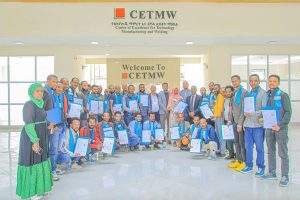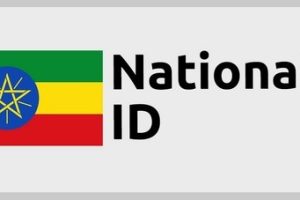
It has been 80 years since the world’s first eye bank service was established. However, according to documents, a century has already elapsed since the corneal transplantation started to be performed in ophthalmology institutions. Following the first corneal transplantation service, the provision of eye bank service spread from America to Europe and Asia.
Unfortunately, though the service started 100 years ago, it is still in its infancy on the African continent. There is no eye bank that has uninterruptedly provided services for more than twenty-one years in Africa, except the eye banks of Ethiopia and South Africa.
When the eye bank was first introduced in Ethiopia, experts and the general public were highly skeptical. There was also doubt about harvesting corneas, thinking corneal donation could become a demanding task.
However, following the improvements witnessed over the course of time, many people have been able to regain their sight through corneal transplantation donated by individual donors.
Wogayehu Fetene was born and raised in Harar Town. It was in his early years that he lost his sight. As Wogayehu stated to the Ethiopian daily newspaper Addis Zemen, the reason that led him to lose his vision was a corneal scar resulting from a contagious disease known as measles he contracted in his childhood. As a result, he failed to move from place to place by himself, play with his peers, and attend to his education.
However, as soon as the Eye Bank started its operation, he received a corneal transplantation treatment to one of his eyes and regained his eyesight. Then, he started his education again. Six years later, he received another corneal transplant to his other eye, and he restored both of his eyes’ sight. Scoring high marks in his studies and completing his high school education, currently, Wogayehu is pursuing his degree in Marketing and Management.
Wogayehu’s eyesight was restored with corneal tissues donated by volunteers after their death. He never sat simply after receiving cornea tissues and restoring his sight. Rather, by establishing an association called “The Ethiopian Cornea Recipients Association”, he is undertaking various activities aiming to sensitize people to corneal transplantation; encourage them to donate their corneas after death, and give light to others as well as to further strengthen.
According to the Director General of the Ethiopian Blood and Tissue Bank Service, Ashenafi Tazebe (MD), when the Eye Bank of Ethiopia was first established, its main objective was to harvest effective and quality corneas from donors after death; and distribute it in a manner keeping quality and safety to cornea transplantation for citizens who lost their vision due to corneal scar to enable them regain their sight.
From its establishment to September 2024, more than 3 thousand people restored their eyesight by conducting corneal transplants at various medical centers. More than 5,000 people have also signed a pledge document to donate their corneas after his death.
The Eye Bank of Ethiopia, though it has been providing cornea transplant services for the past twenty-one years and has been growing, still has several challenges that it has not overcome yet.
According to a study conducted by the Ministry of Health, there are more than 300,000 people who lost their vision due to cornea scars. Thus, to help those people regain their vision by conducting cornea transplantation, all stakeholders, the community, and non-governmental organizations should support the eye bank in different ways.
As the Director General stated, designating November as a month dedicated to cornea donation, extensive activities are being carried out at the national level. At this specific month, a variety of activities will be done. However, the main task will be to inform society about cornea donation, cornea scars, and the social problems it causes, as well as the process of cornea donation, and to encourage people to pledge cornea donation while they are alive and donate upon their death.
In addition to this, in November, activities such as advocacy, mobilization, and awareness-raising work about the Eye Bank will be carried out in the presence of senior government officials. Simultaneously, on the actual day, mobile text messages will be sent to the general community; awareness awareness-raising campaign will also conducted through social and mainstream media about cornea donation. What is more, advocacy events will be organized with religious fathers, Abbaa Gadas, and the House of Representatives.
Concurrent with this, awareness-raising activities and pledging programs will be carried out in various schools, universities, and public spaces.
According to a study, out of the total citizens who are residing in Ethiopia and lost their visions, close to 20 percent have cornea scars. And the Eye Bank in its twenty-one-year journey, more than 3,500 citizens can receive cornea transplantation services. About 15,000 citizens have also pledged to donate their cornea upon their death.
People who underwent the corneal transplantation services are mostly from urban areas. The reason that the service is confined in Addis Ababa, aside from Mekele, Gondar, Hawassa, and Jimma, it is not possible to say that the service is accessible for all and the number of citizens who have received the medical service is at the desired level. Even the corneal tissues harvested by the Bank are low. This shows the need to work a lot in terms of raising the awareness of the people about corneal donation and expanding the services across the country.
The Eye Bank also revealed its plan to open eye banks in all states and at least one eye bank in this fiscal year.
This year, for the first time in Ethiopia, “Cornea Donation Month” is being marked under the theme, “Don’t bury the light; be the reason for those people who lost their vision due to cornea scars to regain sight.”
At the same time, the Ethiopian Ophthalmology Professionals Association held its 24th Annual General Meeting on November 8 and 9, 2024. At the meeting, more than 250 ophthalmologists, senior government officials, and representatives of health associations participated. At the conference, new studies and pieces of research work in the field of eye treatment were presented and discussed thoroughly.
BY MENGISTEAB TESHOME
THE ETHIOPIAN HERALD THURSDAY 21 NOVEMBER 2024





